机器人学导论-JohnJCraig - v1
- 格式:pptx
- 大小:788.60 KB
- 文档页数:12
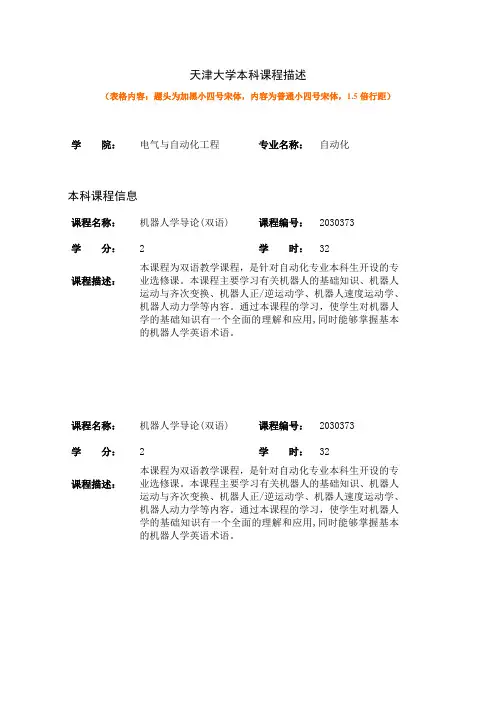
天津大学本科课程描述(表格内容:题头为加黑小四号宋体,内容为普通小四号宋体,1.5倍行距)学院:电气与自动化工程专业名称:自动化本科课程信息课程名称:机器人学导论(双语) 课程编号:2030373学分: 2 学时:32课程描述:本课程为双语教学课程,是针对自动化专业本科生开设的专业选修课。
本课程主要学习有关机器人的基础知识、机器人运动与齐次变换、机器人正/逆运动学、机器人速度运动学、机器人动力学等内容。
通过本课程的学习,使学生对机器人学的基础知识有一个全面的理解和应用,同时能够掌握基本的机器人学英语术语。
课程名称:机器人学导论(双语) 课程编号:2030373 学分: 2 学时:32课程描述:本课程为双语教学课程,是针对自动化专业本科生开设的专业选修课。
本课程主要学习有关机器人的基础知识、机器人运动与齐次变换、机器人正/逆运动学、机器人速度运动学、机器人动力学等内容。
通过本课程的学习,使学生对机器人学的基础知识有一个全面的理解和应用,同时能够掌握基本的机器人学英语术语。
Course Description(表格内容:题头为加黑小四号Times New Roman,内容为普通小四号Times New Roman,1.5倍行距)School:School of ElectricalEngineering andAutomationMajor:Automation EngineeringInformation of undergraduate courses:Title:Introduction of Robotics Code:2030373 Credit points:32 Hours: 2Course Description: Spatial description of rigid body, homogeneous transformation; link description of robot manipulator, the derivation of D-H table; the solvability of inverse kinematics problem, examples of PUMA 560 robots' inverse kinmeatics; linear and angular velocity of rigid bodies, derivation of Jacobian matrix; using Larange and Netwon-Euler methods to calculate dynamic equations for a rigid bodyTitle:Introduction of Robotics Code:2030373 Credit points:32 Hours: 2Course Description: Spatial description of rigid body, homogeneous transformation; link description of robot manipulator, the derivation of D-H table; the solvability of inverse kinematics problem, examples of PUMA 560 robots' inverse kinmeatics; linear and angular velocity of rigid bodies, derivation of Jacobian matrix; using Larange and Netwon-Euler methods to calculate dynamic equations for a rigid body。
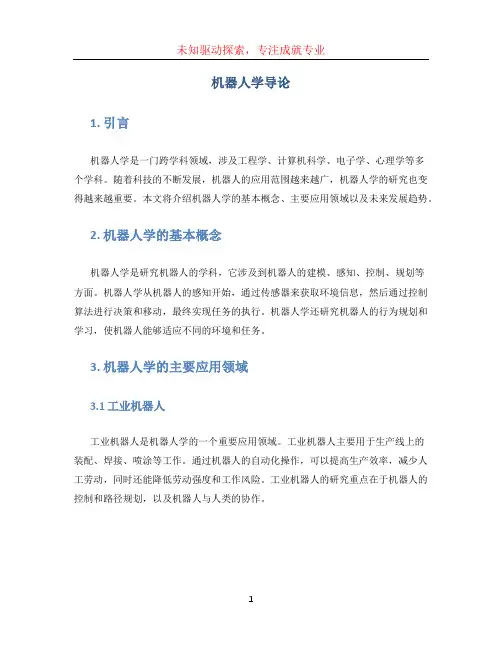
机器人学导论1. 引言机器人学是一门跨学科领域,涉及工程学、计算机科学、电子学、心理学等多个学科。
随着科技的不断发展,机器人的应用范围越来越广,机器人学的研究也变得越来越重要。
本文将介绍机器人学的基本概念、主要应用领域以及未来发展趋势。
2. 机器人学的基本概念机器人学是研究机器人的学科,它涉及到机器人的建模、感知、控制、规划等方面。
机器人学从机器人的感知开始,通过传感器来获取环境信息,然后通过控制算法进行决策和移动,最终实现任务的执行。
机器人学还研究机器人的行为规划和学习,使机器人能够适应不同的环境和任务。
3. 机器人学的主要应用领域3.1 工业机器人工业机器人是机器人学的一个重要应用领域。
工业机器人主要用于生产线上的装配、焊接、喷涂等工作。
通过机器人的自动化操作,可以提高生产效率,减少人工劳动,同时还能降低劳动强度和工作风险。
工业机器人的研究重点在于机器人的控制和路径规划,以及机器人与人类的协作。
3.2 服务机器人服务机器人是机器人学的另一个重要应用领域。
服务机器人主要用于日常生活中的家庭、商业和医疗服务。
服务机器人可以帮助人们完成家庭清洁、物品搬运、老人照顾等任务。
同时,服务机器人还可以在商业场所提供导航、问询、点餐等服务。
服务机器人的研究重点在于机器人的交互设计和人机接口。
3.3 军事机器人军事机器人是机器人学的另一个重要应用领域。
军事机器人主要用于军事作战、侦查和救援任务。
军事机器人能够在危险环境中代替士兵执行任务,从而减少人员伤亡。
军事机器人的研究重点在于机器人的自主导航、目标识别和武器装备。
4. 机器人学的未来发展趋势随着科技的不断进步,机器人学在未来将有更广阔的发展前景。
以下是机器人学的几个未来发展趋势:4.1 智能化未来的机器人将具备更强的智能化能力。
通过人工智能、机器学习和深度学习等技术的发展,机器人将能够更好地理解和适应复杂环境,具备更强的学习、思考和决策能力。
4.2 协作性未来的机器人将更加注重与人类的协作。
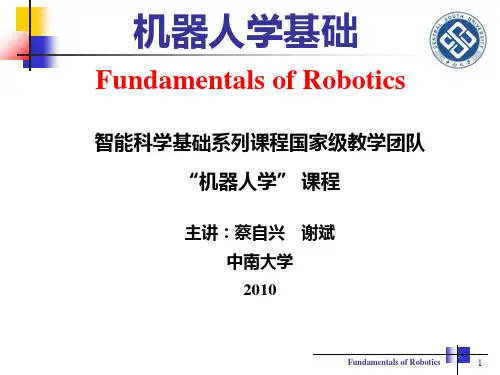
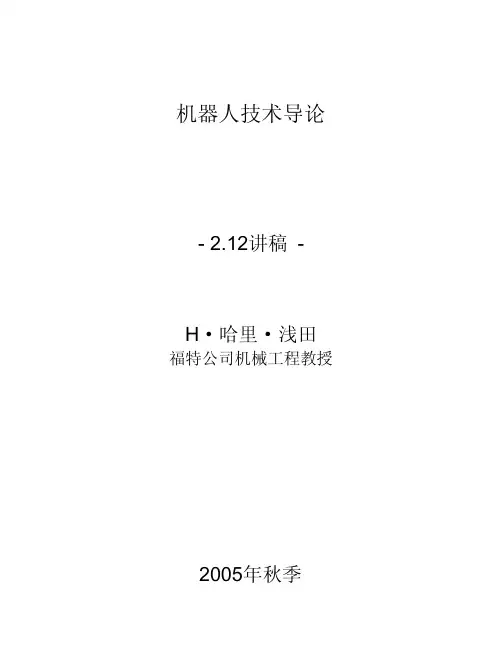
机器人技术导论- 2.12讲稿 - H·哈里·浅田福特公司机械工程教授2005年秋季机器人技术导论,H·哈里·浅田 1第一章前言我们所说的“机器人”,有各种各样的概念,这个词包罗万象,即可以代表简单的物料处理装置,也可以代表高级的类人机器人,而研究人员、工程师、机器人制造商制作出来的机器人,也是千变万化。
目前被大部分人所接受的机器人概念,是指乔治·C·德沃尔最先发明的工业用可编程物料处理装置。
1954年,德沃尔申请了一种新型零件传送装置的美国专利,他把这种装置的基本控制原理称为“示教再现”。
这个原理目前已经被今天的工业机器人广泛采用。
1.1 工业机器人的时代划分德沃尔的工业机器人,具备机器人技术的两个基本特征:数控和遥控。
数控是根据存储的数据,执行控制动作的一种程序,用于机械工具。
存储的数据包括控制机械运动的点坐标数据、控制操作开始/停止的时钟信号、用于分层控制序列的逻辑语句。
整个操作顺序及其可能的变化,都事先编好程序、储存在存储器里面,这样无需对主要硬件进行重大调整就可以完成各种任务。
现代制造系统面临大量的小批量生产任务,而不是长时间大量生产同一种产品,因此模具和生产计划的改变非常频繁,要求制造系统富有灵活性。
生产线适合大规格生产,但是不具备这种灵活性(图1-1)。
单一用途的生产线,不论原始投资多么巨大,在要求改变主要产品的时候往往不能适应变化,已经失去了竞争优势。
在最近几十年手工操作单位制造成本生产线转换批量图1-1 制造成本与批量的基本关系机器人技术导论,H ·哈里·浅田 2里,灵活自动化已经成为制造业改革的核心问题,而数控对提高系统的灵活性起着关键作用。
现在的工业机器人都是可编程机械,只要简单地修改存储的数据,就能实现各种操作:这就是数控的应用效果。
遥控操作器也是现代工业机器人的起源之一,这是一种能够远距离执行任务的机械装置,在操作人员无法接近、或者不安全的环境中执行任务,例如,处理放射性物质、深海作业和空间作业等等。
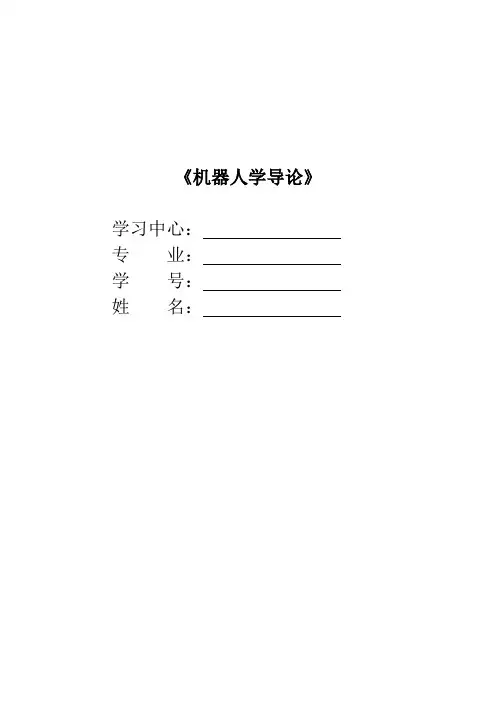
《机器人学导论》学习中心:专业:学号:姓名:一、名词解释:1.自由度2.运动学3.动力学4.虚功原理5.脱机编程二、简答题:1.机器人学主要包含哪些研究内容?2.什么是牛顿-欧拉动力学法和拉格朗日方法?3.简述机器人力觉传感器的分类及用途。
4.为什么要做图像的预处理?机器视觉常用的预处理步骤有哪些?5.仿人机器人的关键技术有哪些?三、论述题:1.试论述机器人技术的发展趋势。
2.试论述精度、重复精度与分辨率之间的关系。
3.机器人控制系统的基本单元有哪些?4.智能控制的特点有哪些?5.脱机编程方式有哪些优点?6.简述采用工业机器人的步骤。
四、计算题:1.已知点u的坐标为[7,3,2]T,对点u依次进行如下的变换:(1)绕z轴旋转90°得到点v;(2)绕y轴旋转90°得到点w;(3)沿x轴平移4个单位,再沿y轴平移-3个单位,最后沿z轴平移7个单位得到点t。
求u, v, w, t各点的齐次坐标。
2.如图所示为具有三个旋转关节的3R 机械手,求末端机械手在基坐标系{x 0,y 0}下的运动学方程。
3.如图所示两自由度机械手在如图位置时(θ1= 0 , θ2=π/2),生成手爪力 F A = [ f x 0 ]T 或F B = [ 0 f y ]T 。
求对应的驱动力 τA 和τB 。
0x f ⎤⎥⎦4.如图所示的两自由度机械手,手部沿固定坐标系在手上X 0轴正向以1.0m/s 的速度移动,杆长l 1=l 2=0.5m 。
设在某时刻θ1=30°,θ2=-60°,求该时刻的关节速度。
已知两自由度机械手速度雅可比矩阵为1121221211212212l s l sl s l c l c l c θθ---⎡⎤=⎢⎥+⎣⎦J。
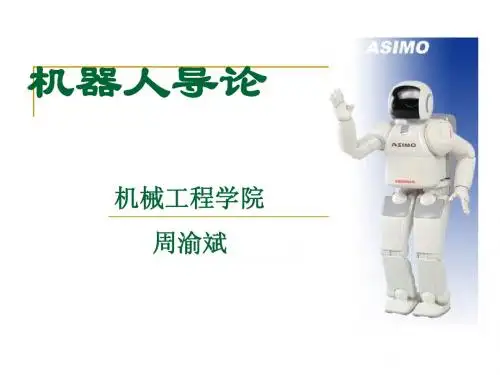
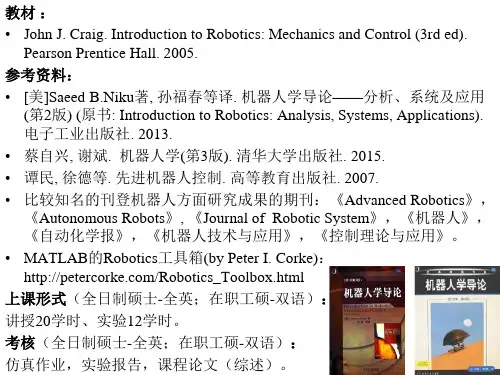

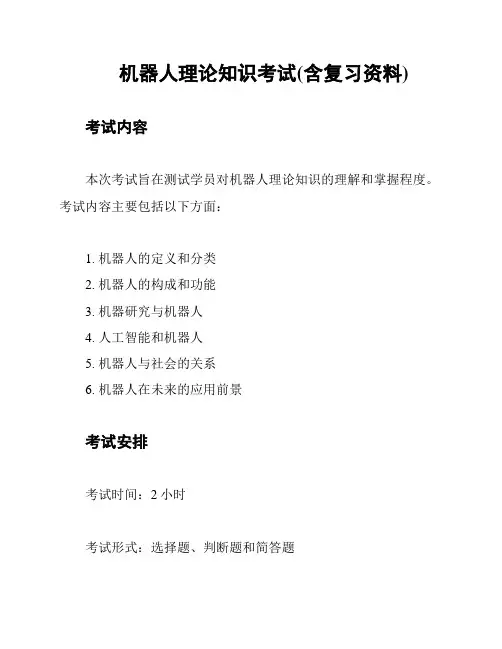
机器人理论知识考试(含复习资料)考试内容
本次考试旨在测试学员对机器人理论知识的理解和掌握程度。
考试内容主要包括以下方面:
1. 机器人的定义和分类
2. 机器人的构成和功能
3. 机器研究与机器人
4. 人工智能和机器人
5. 机器人与社会的关系
6. 机器人在未来的应用前景
考试安排
考试时间:2小时
考试形式:选择题、判断题和简答题
考试要求:
- 阅读题目时请仔细理解问题,并在答题卡上选出正确答案或写出正确的答案。
- 选择题和判断题,每题只能选出一个答案或选择正确/错误。
- 简答题,需用简洁清晰的语言回答问题,尽量阐述自己的观点。
复资料
为了帮助学员复,以下是一些参考资料提供给大家:
1. 《机器人学导论》
- 作者:John J. Craig
- 出版社:机械工业出版社
- ISBN:978-7-111--0
2. 《机器人与人工智能导论》
- 作者:黄铁军
- 出版社:科学出版社
- ISBN:978-7-03--2
3. 《机器人学及其应用》
- 作者:石虎
- 出版社:高等教育出版社
- ISBN:978-7-04--7
请学员们合理安排研究时间,认真复相关知识,以便在考试中取得好成绩。
祝大家考试顺利!。
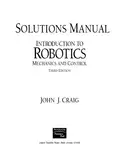
S OLUTIONS M ANUALI NTRODUCTION TOR OBOTICSM ECHANICS AND C ONTROLT HIRD E DITIONJ OHN J.C RAIGUpper Saddle River, New Jersey 07458Associate Editor: Alice DworkinExecutive Managing Editor: Vince O'BrienManaging Editor: David A. GeorgeProduction Editor: Craig LittleSupplement Cover Manager: Daniel SandinManufacturing Buyer: Ilene Kahn©2005 by Pearson Education, Inc.Pearson Prentice HallPearson Education, Inc.Upper Saddle River, NJ 07458All rights reserved. No part of this book may be reproduced in any form or by any means, without permission in writing from the publisher.The author and publisher of this book have used their best efforts in preparing this book. These efforts include the development, research, and testing of the theories and programs to determine their effectiveness. The author and publisher make no warranty of any kind, expressed or implied, with regard to these programs or the documentation contained in this book. The author and pub-lisher shall not be liable in any event for incidental or consequential damages in connection with, or arising out of, the furnishing, performance, or use of these programs.Pearson Prentice Hall®is a trademark of Pearson Education, Inc.This work is protected by United States copyright laws and is provided solely for the use of instructors in teaching their courses and assessing student learning. Dissemination or sale of any part of this work (including on the World Wide Web) will destroy the integrity of the work and is not permitted. The work and materials from it should never be made available to students except by instructors using the accompanying text in their classes. All recipients of this work are expected to abide by these restrictions and to honor the intended pedagogical purposes and the needs of other instructors who rely on these materials.Printed in the United States of America10 9 8 7 6 5 4 3 2 1ISBN 0201-54362-1Pearson Education Ltd., LondonPearson Education Australia Pty. Ltd., SydneyPearson Education Singapore, Pte. Ltd.Pearson Education North Asia Ltd., Hong KongPearson Education Canada, Inc., TorontoPearson Educación de Mexico, S.A. de C.V.Pearson Education—Japan,TokyoPearson Education Malaysia, Pte. Ltd.Pearson Education, Inc., Upper Saddle River, New Jersey。
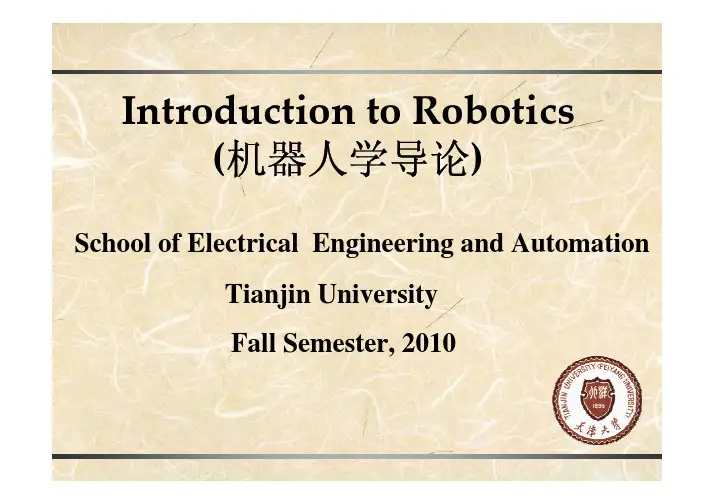
Introduction to Robotics(机器人学导论)School of Electrical Engineering and AutomationTianjin UniversityFall Semester, 2010•Time: Monday Night(Room 115, Section A,Building No. 26)Week 1st to Week 8th•Instructor: Dr. Xian, Bin (鲜斌)•Office: Room 525, Section E, Building No.26•Office Hours: 3:00 pm to 5:00 pm, Wednesday •E-mail : xbin@•Text Book and Reference Books1.John J. Craig, Introduction to Robotics: Mechanics AndControl, Third Edition, Pearson Education, 2005.约翰J. 克拉格,机器人学导论,机械工业出版社,2006.¥49$732.Saeed B. Niku, 机器人学导论-分析、系统及应用,孙富春等翻译,电子工业出版社,2004.3. Mark W. Spong, M. Vidyasagar, Robotics and Control, John Wiley& Sons, 2004.•Grading: Homework 20%Final exam 80%•Course Outline1.Background and Introduction2.Rigid Motion and Homogeneous Transformation3.Forward Manipulator Kinematics4.Inverse Manipulator Kinematics5.Velocity Kinematics6.Manipulator Dynamics7. Control of ManipulatorsChapter 1 IntroductionHollywood’s RobotsR2-D2T800Ch1.1Background1. What is a robot?By general agreement, a robot is:A programmable machine that imitates the actions orappearance of an intelligent creature–usually a human.A robot (industrial robot) is a reprogrammable,multifunctional manipulator designed to move materials, parts, tools, or specialized devices, through variable programmedmotions for the performance of a variety of tasks.(definition from Robotics Institute of American)¾ A Robot is controlled by a computer or similar device.¾ A Robot can be easily re-programmed.2.JIRA Standards for Robot¾Human-Controlled System¾Fixed Sequence Robot¾Alterable Sequence Robot¾Playback RobotRIA ¾Numerical Controlled Robot¾Intelligent Robot•Type of robots¾Robot Manipulator¾Ground Mobile Robot¾Under Water Robot¾Humanoid Robot3.What is Robotics?¾Robotics is the technology and knowledge that are used for design and application of robots.4.Robotics is a interdisciplinary research area:¾Mechanical Engineering: methodologies for the study of machine in static and dynamic situation …¾Electrical Engineering: design of sensor, actuator, interface, control algorithms, ….¾Computer Sciences: software, vision, intelligence….¾Mathematics¾BiologyCh1.2History of Robotics1.1922, Karel Capkef’s novel “Rossum’s Universal Robots”,--Rabota2.1952, First Numerical Control Machine Tool by MIT3.1954, First Re-programmable Robot by George Devol4.1955, Homogeneous Transformation by Denavit &Hartenberg5.1962, First Industry Robot by Unimation6.1968, First Intelligent Robot (Shakey)by SRI7.1972, Cartesian Space Robot by IBM (to IBM7565 Robot)8.1973, T3 Robot by Cincinnati Mialcron9.1978, PUMA Robot by Unimation10.1983, Robotics course were provided in many universitiesStanford Research Institute ---ShakeyUnimation-Puma RobotCh1.3Components of Robot •What a robot will contain?1.Manipulator or Mobile Vehicle2.End-effector3.Actuator: Servo Motor, Stepper Motor, HydraulicCylinder…4.Sensor: Resolvers/Potentiometers, Tachometer, StrainGauge, Encoder…5.Controller6.Processor7.Software: OS, Robot Software, Application Routines …Ch1.4Architecture of RobotEnvironmental sensors Motionplanner ControllerMechanicalStructureConfigurationsensorProcessorPower Supply CommunicationUser InterfaceCh1.5DOF of Robot•The Number of degree of freedom: the number of independent position variables that would have to bespecified in order to locate all the parts of the mechanism.•How to determine the location of a point in three dimension space?•How to determine the location of a rigid objective in three dimension space?Both position and orientation of the objective are needed!•For the robot with DOF greater than 6, there is no identical solution for the system.•What is the number of DOF for human’s arm?•Due to the structure of actuator, there is limited DOF, i.e,0.5 DOF.A B•Number of DOF for robot is determined by its application,i.e, robot for PCB assembly often has 3.5 DOFCh1.5Robot Joints•Main types: Rotary Joint, Prismatic Joint, and Ball Joint•It is customary to classify robots of kinematically simple class according to the design of their joints(the positioningstructure).•P: Prismatic JointR: Rotary JointS: Ball Jointi.e, 3P3R, 2RSCartesian (3P)Cylindrical (R2P)Spherical(2RP)Articulated (3R)SCARA: Selectively Compliant Assembly Robot ArmAdept Cobra s350 (2RP)Ch1.7Performance of Robot •Load Capacity: depends upon the size of its structural members, power-transmission systems and actuator. Example: Adept S1700 6 Axis Robot, Wight 280kg, payload 10kg(rate)/20kg(maximum)•Workspace: The maximum distance that the robot can reached within its working area.•Speed: be determined by robot’s application.•Accuracy: how accurately a robot can reach its destination, some industry robots can meet 0.001 inch ( or 0.0254mm) or higher accuracy.•Repeatability: the accuracy for a robot to reach the same destination for given times, most industry robots can reach0.001 inch or higher level.Ch1.8Application of Robot •Installed Industry Robots•Industry¾Welding¾Painting¾Assembly¾Pick and Place¾Diagnosis•Biotechnology¾Micro/Nano Manipulation¾Sample Handling¾Automated Analysis•MedicalSurgery, Rehabilitation ….•Military Application ¾Reconnaissance¾Battle field fighting¾Search¾Rescue•Space ExplorationMars Exploration Rovers: twin robot geologist, landed on Mars on Jan 3and 4, 2004Chinese Lunar Rovers: test inthe desert•EntertainmentSony QrioSony I-sobot RobotHonda ASIMOSony Qrio ---Fan DanceCh1.9Robot Coordinate System •Global Reference Coordinate System (frame)XY Z•Joint Reference Coordinate System (frame)XYZ(base)1θ2θ3θ•Tool Reference Coordinate System (frame)XYZ(base)X1Y1Z1Ch1.10Forward Kinematics •Kinematics: the science of motion that treats motion without regard to the forces which cause it.•Within the sciences of kinematics, we study position, velocity, acceleration and all higher derivative of theposition variables.•Kinematics refers to all the geometrical and time-based properties of the motion.•Forward kinematics: static geometrical problem of computing the position and orientation of the end-effector of the manipulator.•Given a set of joint angles, how to compute the position an orientation of the tool frame relative to the base frame.XYZ(base)X1Y1Z11θ2θ3θ•Inverse Kinematics: given the position and orientation of the end-effector, calculate all possible set of joint angles that could be used to attain this specified position and orientation.XYZ(base)X1Y1Z11θ2θ3θCh1.11Inverse Kinematics•This problem can be considered as a mapping of locations in external 3-D Cartesian space to locations in the robot’sinternal joint space.•The inverse kinematics problem is more complicate than the forward kinematics¾The kinematic equations are nonlinear, the solutionprocedure is not always easy.¾Existence of the solution? and multiple solution?Ch1.12Velocity Kinematics •Velocity Kinematics: derive the velocity relationship, relating the linear and angular velocities of the end-effector (or any other point on the robot) to the joint velocitiesXYZ(base)vw3θ2θ1θ•Jacobian Matrix: specifies a mapping from velocities in the joint space to velocities in the Cartesian space.•The nature of this mapping changes as the configuration of the robot varies.•Singularities: at certain points, the mapping is not invertible.Ch1.13Robot Dynamics •Dynamics: study devoted to study the force required to cause motion.XYZ(base)AV 1τ2τ3τ•The exact form of the required actuator torquedepends on mass properties of the robotlink/payload, the attributes of the path taken by the end-effector.•Robot dynamic mode can be utilized in¾calculating the desired actuator torque functionto drive the robot to follow desired trajectory¾simulationCh1.14Robot Control•Why need to consider robot control problem?¾The vast majority of manipulator are driven byactuators that supply a force or a torque to cause themotion of robot.¾An algorithm is needed to compute torque/force thatwill caused the desire motion.•Linear position control: control algorithm design based on linear approximations to the dynamics of a robot.•Nonlinear position control: control algorithm design based on the nonlinear dynamics of a robot.Ch1.15Summary •Definition and classification of robot •History of robot•Structure of robot•Application of robot•Basic concepts of robotics•Research on open problem¾Manipulation, Locomotion¾Navigation, Control¾Learning an Adaptation (AI)¾Human-Robot Interaction¾Biologically inspired robotThank You!。
《机器人学导论》课程教学大纲课程名称:机器人学导论课程编号:BF(英文):Introduction to Robotics先修课程:线性代数、机构学、自动控制适用专业:机械电子、机械工程及自动化开课系(所):机械与动力工程学院机器人研究所教材和教学参考书:1.1.教材:机器人学、蔡自兴、清华大学出版社、20002.教学参考书: 机器人学导论,约翰J.克雷格、西北工业大学出版社、1987 注:上述教材和参考书将根据教材课购买情况可互换一、一、本课程的性质、地位、作用和任务面对21世纪知识经济时代的机遇与挑战,人类(地球人)正在以非凡的智慧构思新世纪的蓝图。
世界的明天将更加美好。
但是,地球人在发展中也面临着环境、人口、资源、战争和贫困等普遍问题,同时还要学会与机器人共处,这是21世纪地球人必须正视和处理的紧要问题,是影响地球人生存和发展的休戚与共的重大事件。
机器人学是一门高度交叉的前沿学科,机器人技术是集力学、机械学、生物学、人类学、计算机科学与工程、控制论与控制工程学、电子工程学、人工智能、社会学等多学科知识之大成,是一项综合性很强的新技术。
自第一台电子编程工业机器人问世以来,机器人学已取得令人瞩目的成就。
正如宋健教授1999年7月5日在国际自动控制联合会第14届大会报告中所指出的:“机器人学的进步和应用是本世纪自动控制最有说服力的成就,是当代最高意义上的自动化。
”机器人技术的出现与发展,不但使传统的工业生产面貌发生根本性的变化,而且将对人类的社会生活产生深远的影响。
二、二、本课程的教学内容和基本要求1.1.绪言简述机器人学的起源与发展,讨论机器人学的定义,分析机器人的特点、结构与分类。
2.2.机器人学的数学基础空间任意点的位置和姿态变换、坐标变换、齐次坐标变换、物体的变换和逆变换,以及通用旋转变换等。
3.3.机器人运动方程的表示与求解机械手运动姿态、方向角、运动位置和坐标的运动方程以及连杆变换矩阵的表示,欧拉变换、滚-仰-偏变换和球面变换等求解方法,机器人微分运动及其雅可比矩阵等4.4.机器人动力学机器人动力学方程、动态特性和静态特性;着重分析机械手动力学方程的两种求法,即拉格朗日功能平衡法和牛顿-欧拉动态平衡法;然后总结出建立拉格朗日方程的步骤5.5.机器人的控制机器人控制与规划6.6.机器人学的现状、未来包括国内外机器人技术和市场的发展现状和预测、21世纪机器人技术的发展趋势、我国新世纪机器人学的发展战略等。
关于机器人的书机器人是一种人工智能技术的产物,它们可以执行各种任务,从简单的家庭清洁到复杂的工业制造。
机器人的发展已经成为了现代科技的一个重要领域,也成为了人类未来的一个重要方向。
在这个领域中,有很多优秀的书籍,下面就介绍几本值得一读的机器人书籍。
《机器人学导论》《机器人学导论》是一本经典的机器人学教材,由美国斯坦福大学的机器人学教授John J. Craig所著。
这本书详细介绍了机器人学的基本概念、机器人的运动学、动力学、控制和传感器等方面的知识。
这本书的特点是理论与实践相结合,既有深入的理论分析,又有丰富的实例和案例分析,非常适合机器人学初学者和研究者阅读。
《机器人革命》《机器人革命》是一本介绍机器人技术发展历程的书籍,由美国机器人专家Rodney Brooks所著。
这本书从机器人的起源开始,介绍了机器人技术的发展历程,包括机器人的应用领域、机器人的设计和制造、机器人的控制和感知等方面的内容。
这本书的特点是通俗易懂,语言简洁明了,非常适合普通读者阅读。
《机器人的未来》《机器人的未来》是一本介绍机器人技术未来发展趋势的书籍,由美国机器人专家Hans Moravec所著。
这本书从机器人技术的当前状况开始,预测了未来机器人技术的发展趋势,包括机器人的智能化、机器人的自主性、机器人的应用领域等方面的内容。
这本书的特点是前瞻性强,思维深入,非常适合机器人技术研究者和决策者阅读。
《机器人的伦理与法律》《机器人的伦理与法律》是一本介绍机器人伦理和法律问题的书籍,由美国机器人专家Patrick Lin等人所著。
这本书介绍了机器人技术对人类社会带来的伦理和法律问题,包括机器人的道德问题、机器人的隐私问题、机器人的责任问题等方面的内容。
这本书的特点是深入浅出,案例丰富,非常适合机器人技术研究者、决策者和公众阅读。
总之,机器人技术是一个非常重要的领域,它的发展将会对人类社会产生深远的影响。
以上介绍的几本机器人书籍,不仅涵盖了机器人学的基础知识,还介绍了机器人技术的发展历程、未来趋势以及伦理和法律问题等方面的内容,非常适合机器人技术研究者、决策者、公众和学生阅读。